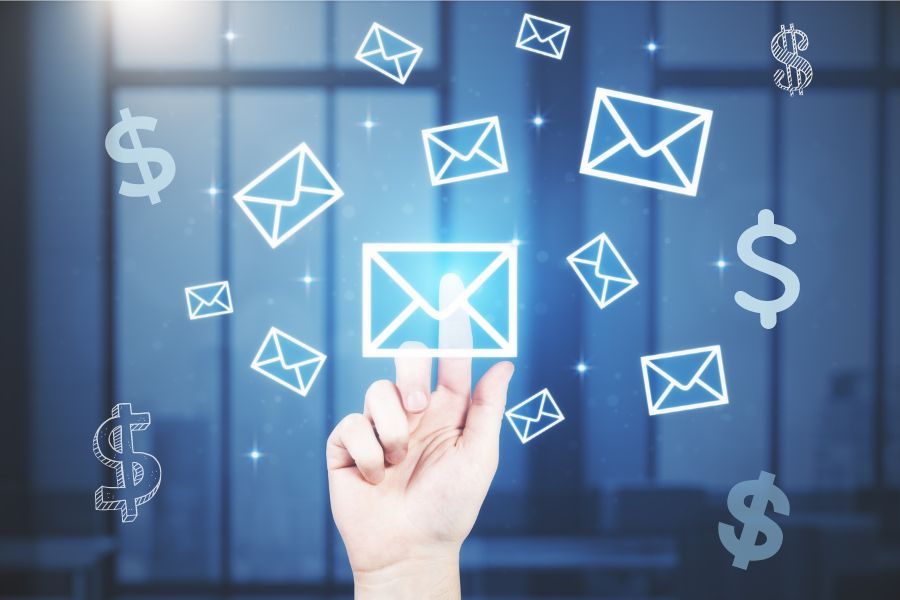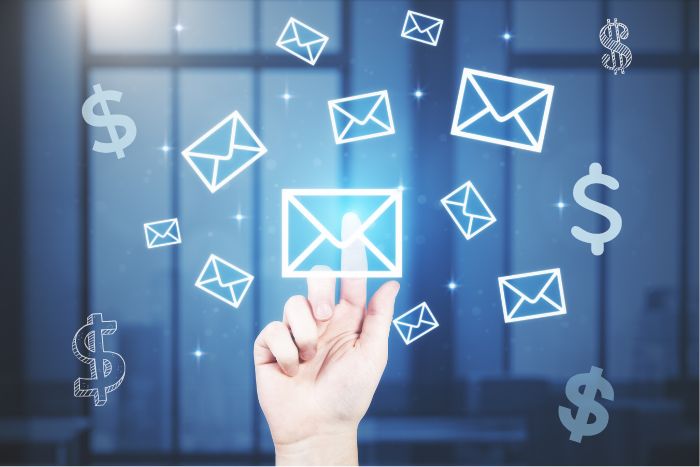Can affiliate email marketing make you money while you sleep?
Yes, and how does a mind-blowing ROI of $36 for every $1 spent sound?
Pretty incredible!
And in this post, we’ll show you how to get your slice of the extremely lucrative affiliate marketing pie.
Here’s what you’ll learn:
- What to do before, during, and after launching an affiliate email marketing campaign.
- Simple but effective email marketing best practices.
- Need to know tips that’ll elevate your next campaign.
Let’s go!
What is Affiliate Email Marketing?
Affiliate email marketing is a form of digital marketing that promotes affiliate products and services via an email list.
You earn a commission when someone buys something or performs a desired action (like signing up for a webinar) through your affiliate link contained in that email.
What’s the Difference Between Email Marketing and Affiliate Email Marketing?
Affiliate email marketing is a subset of email marketing that uses a list of email subscribers to promote someone else’s products and services through affiliate programs and links.
An affiliate email campaign can link to physical products, invite people to a webinar, direct them to a social media post, and so on.
Email marketing is similar except the marketing is for that business’s own products.
Here is an example of email marketing, where Uber offers a free ride just for signing up to their mailing list:
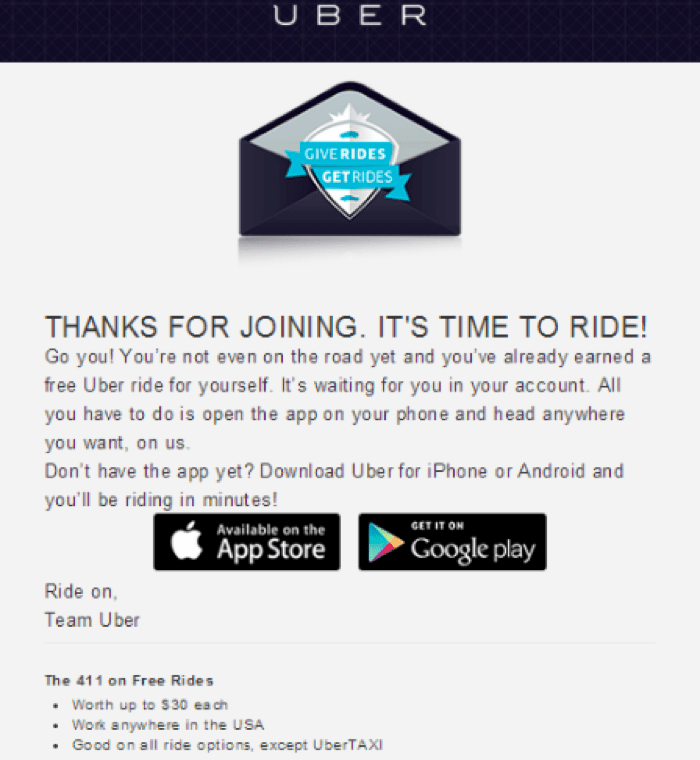
And here’s an example of affiliate email marketing where Pat Flynn promotes CovertKit in one of his emails. Note the affiliate link.
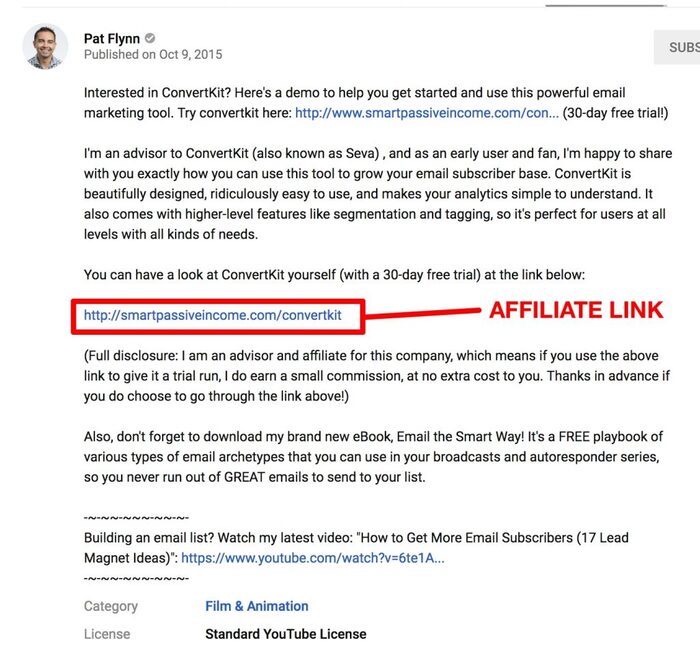
But the bottom line: Uber’s marketing strategy was to promote their own product in their email, but Pat Flynn’s was to promote someone else’s.
How to Launch an Affiliate Email Marketing Campaign in 3 Steps
No matter what part of the affiliate email marketing process you’re in, we’ve got you covered.
So feel free to skip around depending on what part applies to you.
Step 1: Before Launch
Start here if you don’t have an email service provider (EMS), an email list, or know what the CAN-SPAM is.
Step 2: Launch
Start here if you don’t have the right affiliate links or haven’t learned how to write an email using them.
Step 3: After Launch
Start here if you want to learn how feedback and analytics can improve your results.
1. Before You Launch An Affiliate Email Marketing Campaign
Choose the Right Email Service Provider
An email service provider (ESP) manages bulk email services between you and your group of subscribers. For example, ConvertKit, the email service provider Smart Blogger recommends for most content creators.
But the most important role for an ESP in email affiliate marketing — besides making your life easier — is to build trust, bring value, and provide the best experience possible for your email subscribers.
Here are some must-have email marketing software features:
1. Scalability?
You may find an ESP that meets your needs today, but what about tomorrow? Is there a cap or does it support unlimited emails?
2. Can you track and report?
You’re going to want to know things like deliverability and open rates.
How else are you going to know if your marketing efforts are resonating with your subscribers or if someone needs to be purged from your list?
3. Can you segment?
You don’t want to send offers to people who’ve already bought the product or service. You want the right email going to the right person at the right time.
4. Do they automate?
Why not write emails once and then automate them to send in a sequence? It may be more setup work up front, but it’ll be much less work afterward.
5. Do they offer email templates or builders?
Even if you’re a design wiz, using a prebuilt professional email template or email builder looks great and saves time.
Affiliate Links VS Affiliate Marketing
However, not all email service providers (ESPs) are created equal.
The difference between how an ESP allows the use of affiliate links compared to affiliate marketing can be night and day, and the waters here can get a little murky.
In general:
- Affiliate links market products or services in general or at random to a third-party business.
- Affiliate marketing, on the other hand, markets products or services by teaming up with a specific third-party business.
While most ESPs allow affiliate links, some have more restrictions than others.
For example, the popular email provider Mailchimp allows certain affiliate links but not affiliate marketing.
GetResponse, on the other hand, allows both affiliate links and affiliate marketing.
But these policies are nuanced, so be sure to research your ESP’s specific policy to ensure your affiliate model is a good match, which is something you’ll want to do before sending your first email.
Here’s why…
What’s the CAN-SPAM?
The Controlling the Assault of Non-Solicited Pornography and Marketing Act, (CAN-SPAM) governs the use of commercial emails in the United States.
Other countries may have similar laws.
ESPs, understandably, want to avoid the possibility of facing legal action because one of their users intentionally, or unintentionally, violated the law.
As a result, they all have to follow certain guidelines for emails sent through their service.
Strict adherence to CAN-SPAM is a must. Failure to do so may result in being booted off the platform and possibly permanently losing access to your hard-earned email list.
Whether the ESP you’re considering has a stated policy on its website governing affiliate links or not, reach out to them for clarification to ensure you know EXACTLY what is and what’s not allowed
And now that you’re a CAN-SPAM pro, it’s time to build your email list.
Build an Email List for Affiliate Marketing
The key to building a large email list isn’t in the tactics, it’s in the connection and value offered.
Some strategies, of course, have proven to be more effective than others. But the greatest affiliate marketing techniques in the world won’t work if people don’t feel you can relate to them — and this is especially true for affiliate email marketing.
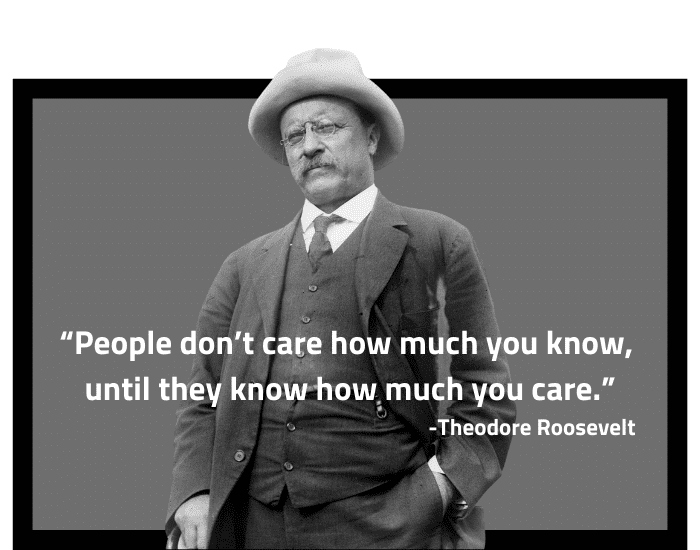
That said, incentives are a brilliant way to provide value to potential customers and build your email list at the same time. Lead magnets and opt-in offers prove upfront that you’re a valuable, trusted resource. And here are some tried and true strategies that you could use:
- Cheat sheets (or checklists)
- White papers
- How-to guides
- Special reports
- Content upgrades
- Contests and giveaways
- Opt-in forms and pop-ups
- Squeeze pages
- Social media
Regardless of the method(s) you choose, keep in mind that it’s going to take time. Mailing lists of thousands of passionate fans aren’t built overnight.
2. How to Launch an Affiliate Email Marketing Campaign
You’ve got your email list and your email service provider, and now you’re ready to make boatloads of that affiliate income.
Now what?
Now it’s time to launch! Well, almost.
What you send won’t matter if no one opens it. Everything needs to work together from the subject to the affiliate links to pique your target audience’s interest, solve their problems, and excite them enough to take action.
Here’s what you need to know:
Subject Lines
If the subject line doesn’t grab their attention and compel the reader to open it, nobody will know about your awesome content or can’t-live-without offer. And worse, since affiliate email campaigns are built on relationships, you’ll miss a valuable opportunity to build trust.
Because the subject of writing winning email subject lines is so important I’d be doing you a disservice if I tried to cover it all here, but here are some important tips to get you started with affiliate email subject lines:
- Create intrigue with sensory and/or power words, instead of “salesy” jargon.
- Highlight the value clearly. How else will your subscribers know it’s worthwhile?
- Present warmly as if you were writing to someone who personally knew.
Hopefully, that gets you started, but click here for a deeper dive into how to write email subject lines that work.
Keep the Body Short
Next, keep the body of your email short. People have short attention spans, and they skim. They’re looking for reasons to hit the back button.
Don’t give it to them.
Hit that pain point immediately in a way that they can’t ignore. The solution to their problem lies in clicking that embedded link.
Links
Speaking of links, you should only include affiliate links to products and services that will truly benefit your audience.
If trust is destroyed, it’s almost impossible to regain, so the links must be catered to your specific audience. But, and this is important, the links must also work well for you — that’s kind of the whole point!
Best Types of Links
You probably don’t want affiliate links to health and personal care as an Amazon Associate, since they only offer a 1% commission.
Instead, consider something like Bluehost, which offers up to $65 per sign-up or referral, it’s something people will need for years to come, and your marketing efforts will get more bang for their buck.
Email Sequences and Triggering
Building trust in affiliate marketing can be a full-time job. But what if you could get better results with less time?
Email sequences are a predesigned group of emails that deploy automatically. That means you can create content once but keep pumping it out on repeat.
But how do you know when it should be sent?
That’s where triggers come in.
Triggers are prompts caused by certain events, like an abandoned cart sequence, a purchase to overcome the inevitable buyer’s remorse that accompanies a high ticket item, or something as simple as a new subscriber welcome email.
You can write it once and then automate it to send as subscribers join the fold or hit certain milestones.
OK, so once you’ve sent emails with value-packed subject lines, built trust with email sequences, and tuned into your audience’s needs and wants, your work is well on its way.
But it isn’t over yet.
3. After You Launch an Affiliate Email Marketing Campaign
By now you’ve fostered trust with well-written email content. You’ve sent links that improve your subscribers’ lives.
Now it’s time to double down on serving your audience and get those recurring commissions!
The best affiliate marketers do this by using the right tools. Tools that answer certain questions.
Like how did your email perform?
How many were opened?
Did any bounce? How many times was the link followed?
In short, does anyone want to buy what you’re selling? And this is where analytics can provide the data to create emails so good your subscribers won’t be able to ignore you.
Open Rates
Open rates track how many sent emails were opened.
Why is this important?
Because people love content that sparks their interest, solves a problem, or helps make a dream come true — emails that provide value. And an open rate of less than 15% – 30% is cause to reconsider your affiliate offer’s value.
Bounce Rates
Bounce rates track how many emails were sent but couldn’t be delivered. Under 2% and you’re good. Higher? Not so good.
Why is this important?
Because a high bounce rate could cause your ESP to start directing your email to spam. And nothing dissolves trust faster than fishing an email out of your spam folder.
To prevent this, have your new subscribers verify their subscriptions. Cut out the “spammy” or “salesy” language, especially in the subject line. Or maybe you just need to clean your list and toss out the duds.
Click-to-Open Rates
Click-to-open rates (CTORs) track how many of your links were clicked when the email that contained the link was opened. After all, this is the whole point of affiliate email marketing.
So if your click-to-open rate is less than 20% – 30% or any of your other analytics are off, it’s time to find out why.
And it’s A/B testing to the rescue.
A/B Testing
A/B testing tests two different versions of the same email. Each one is sent, tracked, and then analyzed for performance.
Low open rates? A/B test with two different value offerings, let’s say a white paper vs. a free course.
Low click-to-open rates? A/B test with two different calls-to-action.
The beauty is that you’ll be able to customize your A/B testing to fit your specific needs. And once you do, you’ll have come full cycle in your affiliate email marketing launch.
So you’re good to go!
But if you want to avoid the painful and embarrassing mistakes newer affiliate email marketers experience, the next section is for you.
Tips & Best Practices for Successful Affiliate Email Marketing
So far you’ve learned the lion’s share of what makes for successful affiliate email marketing.
But there’s no way we could cover everything.
What we can do, though, is circle back and fill in the most helpful blanks with must-have tips and best practices.
That way you can customize content to a higher percentage of readers, open access to free feedback, supercharge the trust and confidence needed to make those affiliate commissions, and more.
1. Segmentation
Some people like widgets. Others like gadgets. While the two markets often overlap, you wouldn’t want to send a follow-up widget email to a gadget buyer, would you? You’ll confuse them and come across as disorganized.
But if you segment your audience into specific groups, it can give you an increased ability to connect with your specific audience, even though they may not all have the same exact needs or preferences (widgets vs gadgets).
And besides that, it’s easier to write a personable subject line or call to action if you can narrow down and segment your audience.
2. Allow Email Replies
Don’t use something like no-reply(at)widgets.com. If people have questions, concerns, or want to give you some feedback, you need to be available. That’s how you learn what your audience wants. Talk with them. Relationships go two ways. And you may get some great ideas for material for future posts if you ensure the lines of communication are open.
3. Keep Your Email Lists Clean
Don’t make your subscribers search for your emails in the spam folder. Because they won’t. A dirty email list sends too many emails to spam or has too many unengaged subscribers.
Some ESPs will even suspend your account if your bounce rate is too high.
So in order to keep your email list clean:
- Purge email addresses with consistently high bounce rates.
- Consider a double opt-in function to ensure people want to be on your list in the first place.
- Create a re-engagement sequence for cold subscribers.
4. Personalize Your Emails
Everybody loves the sound of their name. Which email would you be more likely to open?
One that says,

Or one that says,

As simple as it sounds, personalized emails make (and maintain) personal connections.
5. Verify New Contacts With a Double Opt-In
We all make mistakes. Sometimes people mistype their email address into your contact form. If that happens your content may go to someone not interested in hearing from you, or it’ll be sent to an undeliverable email account.
It’ll look bad on your ESP stats and deprive the reader of your content.
Don’t let this happen to you.
Use a double opt-in.
6. Send a Welcome Email
An automated welcome email is a no-brainer.
Write a valuable email and use your ESP’s marketing automation feature to send it as soon as someone subscribes to start things off right.
The welcome email’s content might offer an exclusive gift, a specific call to action, or just reinforce that this person is a perfect fit for your offer.
Everyone wants to feel important, right?
7. Relationships
Unlike many forms of marketing, where it’s all about the sale, affiliate email marketing is about relationships.
Arguably, this is the most important affiliate email marketing tip there is.
Your role is to sound like that of a satisfied customer sharing good news with a friend over a cup of coffee, and not like a used car salesman trying to make a monthly quota.
Remember, people subscribe to an email list because they perceive value in doing so.
They trusted you.
Abuse that trust, and they’ll unsubscribe or delete your emails without reading them.
Be warm. Be friendly. Be sincere.
Affiliate Email Marketing: Final Thoughts
We’ve just given you our top tips for achieving fame and fortune in the world of affiliate email marketing.
The sky’s the limit if you can connect with your audience and make them eager to read what you have to say.
Never forget that you’re a trusted friend sharing valuable information that’s going to make your readers’ lives happier, healthier, and more fulfilling.
Remember, if you wouldn’t recommend a product or service to a family member, you have no business offering it to your audience, no matter how much it pays.
Put people first, and the money will follow.
